UPCOMING: June 16-22 2025 ~ (Rotterdam, the Netherlands) :: LIVE in WORM :: HAROLD SCHELLINX Post-Post ULTRA (van 1983 tot en dan almaar verdur) :: (it is all) Politics >:> eternity, unPublic, sudoku's, Commuters, 1024, k7, collage, Gentle Slaughter ... Concert on Saturday, June 21. Drinks on Sunday 22!!
SUBSCRIBE to soundblog_un_public our personal / private old-school email newsletter alternative to the use of FB, X, Insta and other surveilling & exploiting media. Our occasional newsletter brings web links to new and not-so-new thoughts, to releases, concert dates, texts related to projects / works by Har$, the ookoi, other collabs, etc.
18 min read 🤓
Situasonnisme: the City Sonic Festival
november 22, 2015.
"Continuons! Continuons à déranger!"
( * )
Between September 11th and September 27th the Belgian city of Mons (in Dutch/Flemish that is: Bergen; both Bergen and Mons of course mean: mountains) for the 13th year in a row hosted - and was part of - the music/sound/art festival City Sonic, organized by Transcultures, under the artistic direction of Philippe Franck, a great lover of music, sound and vibrations of all sorts, and a man with wide open ears and a wide open mind, which is amply reflected by the amazingly broad artistic spectrum that is covered by the many artists and works that were commissioned and/or highlighted by the City Sonic Festival in the now 13 years of its existence, this 2015 edition being additionally boosted by Mons/Bergen being one of the two this year's European capitals of culture.
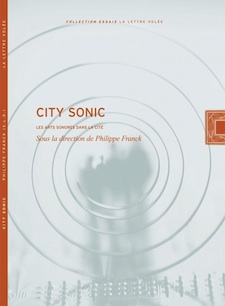 The City Sonic festival is about the same age as this SoundBlog, and at heart both are nurtured by very similar philo-politico-artistic interests and attitudes. Instead of trying to give you an impression in a couple of lines of the many things that over the years could be heard and seen, the many 'sound doors' - sans populisme ni chapelle - that the City Sonic Festival opened (not only) in the city of Mons, let me just refer you to the City Sonic book, a bilingual (French/English) edition published by Transcultures earlier this year. (Here and there the English translation does loose quite a bit of the textual depth present in what was originally written in French, though.) The book is a fine and richly illustrated summary of the first twelve (2003-2014) editions of the festival, and more generally does a great job sketching its artistic and philo-political position. In that context Philippe Franck (in French) likes to speak of situasonnisme, thus expressing the indebtedness that many of us feel (and have) towards Guy Debord and the Situationist International.
The City Sonic festival is about the same age as this SoundBlog, and at heart both are nurtured by very similar philo-politico-artistic interests and attitudes. Instead of trying to give you an impression in a couple of lines of the many things that over the years could be heard and seen, the many 'sound doors' - sans populisme ni chapelle - that the City Sonic Festival opened (not only) in the city of Mons, let me just refer you to the City Sonic book, a bilingual (French/English) edition published by Transcultures earlier this year. (Here and there the English translation does loose quite a bit of the textual depth present in what was originally written in French, though.) The book is a fine and richly illustrated summary of the first twelve (2003-2014) editions of the festival, and more generally does a great job sketching its artistic and philo-political position. In that context Philippe Franck (in French) likes to speak of situasonnisme, thus expressing the indebtedness that many of us feel (and have) towards Guy Debord and the Situationist International.
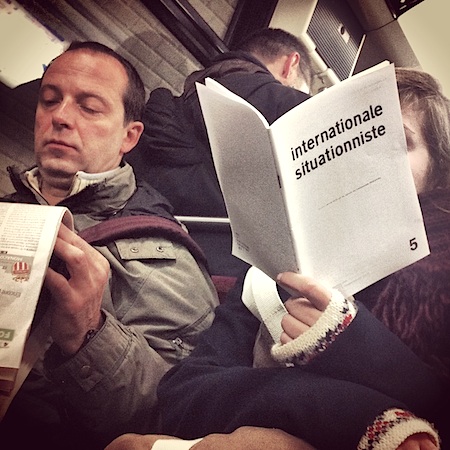
9:51 am on the morning of my 2013 birthday in line 1 of the Parisian metro.
Many of our this summer's activities actually were signed 'City Sonic'. Transcultures and the festival, though proprement dit taking place in Mons over a period of two weeks in September, via partnerships and sponsoring remain highly active also throughout the rest of the year, weblike spreading their tentacles to many places and corners of the earth.
Thus early July already, our three days in Brussels, with the live rendition of the 'String Quartet with windows, open', the K7-art exhibition at Vitrine 5 and our performance with Rébus, Anton Mobin and Jean-Jacques Duerinckx were 'City Sonic', as were the ensuing cassette editions on the Transonic label of my 'live summary of the SQWWO' and a 'K7-sound-art' compilation, with contributions by 'K7-artists' participating in the City Sonic festival.
An impression of the many installations, performances and exhibitions that together made up the 2015 edition of City Sonic is best gained by wandering about the festival's web site, which comes with a veritable avalanche of sounds, images and video clips. In what follows I will limit myself to a short description of the couple of things in this year's City Sonic in Mons that I was involved in personnally.
Following up on the K7-(art-)exhibition in Recyclart's Vitrine 5 in Brussels in July, the weeks of the festival in Mons included a K7-art exhibition in the Mons Médiathèque, with a large selection of photographs from my Found Tapes Exhibition.
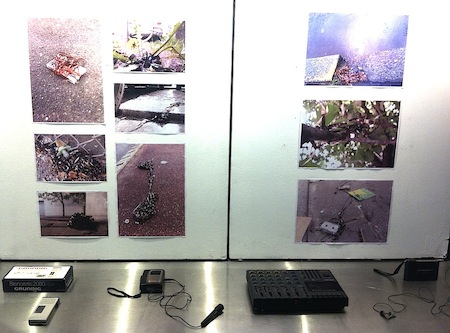
French artist Damien Bourniquel for City Sonic 2015 continued his Portraits Audacieux project, an ongoing series of digital portraits of sound artists, portraits that are both image and sound. The project's name is derived from that of the free open source digital audio editing tool Audacity, often used in the creation of glitch art, as it allows to import raw data, thus allowing to play back and edit as sound pretty much any file on your computer (images, text et cetera). Damien asks the artists he wants to portrait to send him an identity pic (neutral expression and background, no smile). He then transforms this into a sound file. This file is send back to the artist, who is asked to use that file in the creation of two new sound files, not exceeding the file's original length, which is 2 minutes and 17 seconds. These two derived audio files then in turn are sent back to Damien, who makes them into the final hybrid files: digital files that are both viewable as images in pdf format (glitched versions of the original artist pic), and playable as sound in wav format (the sound files the artist came up with by editing and working on top of the sonification of their original identity pic).
The result then is something of a digital picture disc, with an A-side and a B-side, that Damien has cut into vinyl discs for visitors of the Portraits Audacieux exhibitions, like the one that was part of City Sonic 2015 in Mons, to listen to. (Click the images below to go to the corresponding page at Damien's web site, on which you may also can download the playable/viewable hybrid files.)
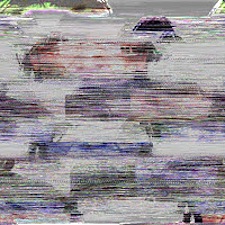 |
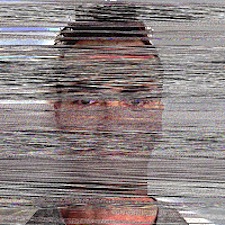 |
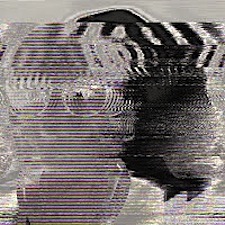 |
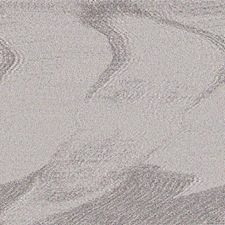 |
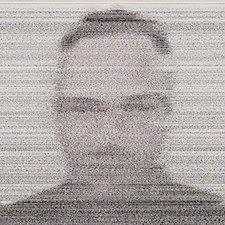 |
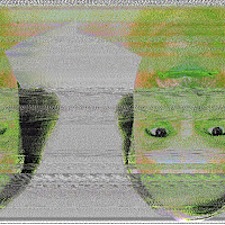 |
An interesting idea, such an ongoing collection of sounding portraits of sound artists. The technique currently applied by Damien has some dis-advantages, though, one being that there seems to be only little variation in the initial sonifications of the artist's pictures: all sound artists sound pretty much the same; they all sound like a helicopter... :-) The main source of variation then are the sounds/music that each one of the artists may layer on top of (an edited version of) this 'helicopter'.
This is the YouTube version of my B-side ( ** ).
Last but not least, Rébus and I were in Mons over the final weekend of September, to participate in this year's City Sonic festival's closing event on Sunday September 27th, a chain of short in situ performances at different outside spots in the city center, ending with an early evening concert in Mons's beautiful new Arsonic concert hall. This 'free improv itinerary' was composed by the Brussels based OMFI (One Moment Free Improv) collective - basically this are Jean-Jacques Duerinckx and Matthieu Safatly. The very informative interview on the City Sonic web site with Jean-Jacques and Matthieu is a must-read, which unfortunately for the moment is available in French only.
During the night that followed the OMFI's closing of City Sonic 2015, our moon eclipsed. Rébus had to rush back to Paris by car, in order to take on obligatory criminal court jury duties the next morning. Underway he shot this picture.
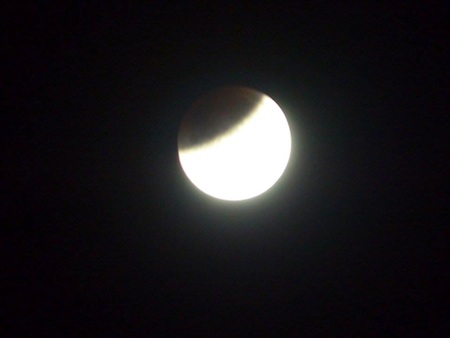
(The following photographs of Rébus and me during the OMFI itinerary and concert at Arsonic were taken by our friends Nicole Lapasin & Laure Barreteau of Alternative teKen.)
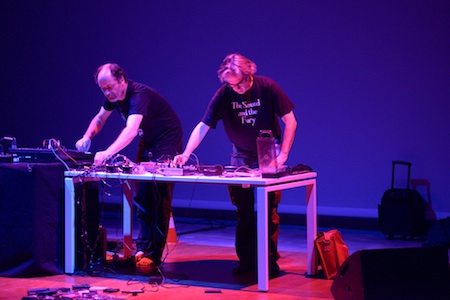
[ Below are my spontaneous direct-to-mail answers (in English), written shortly before catching the train to Mons (on September 26th), to the list of questions (in French) that Philippe Franck had sent me the evening before, on Friday September 25th. You can also find it on the City Sonic website, spiced with a few embedded YouTube video's and Bandcamp albums. ]
"Never look back, unless to look forward."
Qu'est-ce que vous a attiré dans la manipulation de la cassette et du dictaphone ? Comment en êtes-vous venu à cette pratique et comment l'avez-vous développé personnellement ?
[ What is it that attracts you in the manipulation of cassette tapes and dictaphones? How did you arrive at this practice and how did you develop it personally? ]
Starting from the late 1970s, early 1980s, for several decades I used cassette dictaphones along with small lapel microphones to record what I call my 'chronique sonore': an 'audio documen-tentation', of a very lo-fi and sketchy kind, of many of my daily routines; at home, in the metro, in the train, on the beach, in the restaurant; bref, everywhere.
I continued to do this 'audio journal recording' also during the ten, fifteen years (1984-1999) that I kept far from any 'sounding music' making (maybe -maybe- because I needed to recover from something like a 'music allergy', caused by over-exposure), tried to only make 'music without sound'. When, with the turn of the century, I found that this idea was an idée fixe, really just a 'mirage', an illusion, and I decided to return to 'sounding music' making, it felt logical, and maybe even necessary, to do so NOT with the usual instruments, but by delving into this vast 'cassette archive' (rather more of a 'dump', actually) that I had gathered, with near to thirty years of 'audio memories'. That's how around 1999 I started to compose short pieces (in the beginning still on my old TEAC 4-track analog tape machine), exclusively using material from my 'personal audio archive'. For me, this felt like some ultimate form of pop music: making up stories that are built from the day-to-day sounds of your own life :-)
Not much later I began to do something similar in live settings, mostly in Paris. At first by (solo) executing quite elaborate and pretty detailed scripts, using a whole battery of cassette machines to mix longish 'audio stories'.
It was in the course of these live performance settings that gradually (along with several of my friends and colleagues) I uncovered the quite peculiar potential of, especially, handheld dictaphones not merely as playback machines, but as electro-acoustic instruments. However farfetched it may sound, as Emmanuel Rébus likes to say: "A dictaphone is very much like a trumpet; both of them have three buttons!"
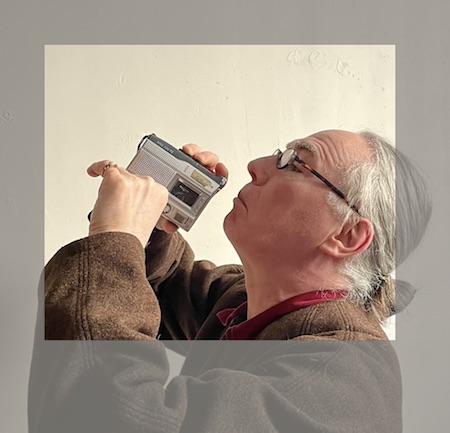
What I find attractive about the 'dictaphone-as-instrument' approach:
1° - it allows for a very mechanical, very physical manipulation
2° - it is very limited in its possibilities, but that's of course a blessing for all who think - like me -that limitation is always a strength
3° - It is impossible to gain perfect control; the little machine continues to show some sort of a will of its own
4° - sooner or later all the world's dictaphones will break down, and become beyond repair; I love this ephemerality, using things that are sure to disappear :-)
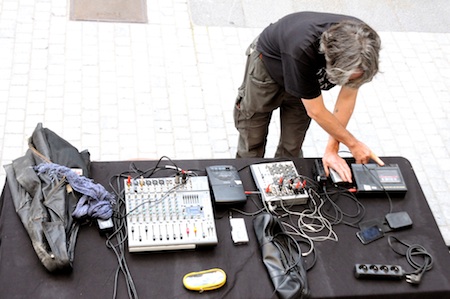
Comment intégrer vous ce médium à vos compositions ?
[ In which ways do you integrate this medium in your compositions? ]
There are two important aspects to this:
1° - a narrative one - this of course depends on what is actually recorded onto the cassette that one uses; I once estimated that in the 50 years of its existence, about 8.55 billion kilometers of cassette tape has been recorded onto; pretty much all the sound of the world can (or could) be found on cassette (it is the - Dutch - title of a small booklet that I wrote on the Found Tapes Exhibition: "Alle Geluid van de Wereld")
2° - the sonic one - this is what the 'dictaphone-as-instrument' is about; important elements are also the typical lo-fi texture of the cassette sound, the noise, the gradual disintegration of the sound and its quality; what is on you cassettes is, in a way, alive: a cassette that one uses regularly in performances never sounds the same twice... (OK, good slogan this one; let's keep it: "K7's never sound the same twice!")
Though I cannot promise you that it will ever be finished, let alone published: I am also writing a book called 'The Art of K7' (referring, very blasphemously to Bach's 'Art of Fugue :-) ...) that - apart from a lot of K7 stories, K7 facts and K7 history (NOT 'cassette culture' history though; that history has been written already) will see an exhaustive description and index of all the possible different performing techniques using cassette players and dictaphones, each one with an exemplary, generic, score for a piece based on that technique.
Among the non-standard techniques, let me mention my 'Sudoku' technique. It is a way to apply something very much like a 'serialist' form of composing/playing to the dictaphone. It can, however, only be used with certain models of a dictaphone. And much to my regret, the one that I used for Sudoku playing (a Sony TCM 500DV) broke down, and I haven't been able to replace it yet ... (A prelude to 'The Art of K7'.)
[ added December 2021: About six years after, find out all about my 'sudokaising' techniques and 'sudokism', starting e.g. from 'Music from Sudoko Solutions'. ]
Vous avez souvent collaboré avec d'autres artistes de la cassette, Emmanuel Rébus ou Anton Mobin récemment ; que vous apporte ces improvisations croisées ?
[ You often collaborate with other artists using cassette tapes, like - recently - Emmanuel Rébus and Anton Mobin. What do such 'cross-improvisation' bring you? ]
Ha, ha! It is so great to be in a band! All the touring, the sex, the drugs, the rock-n-roll ... :-) ... But, seriously, in the past ten years it has turned out that group live improvisation is one of my major musical destinies. Not so much as a choice, but as something that I experience happening. And it is so great to spend musical and sonic time with friends that are also fabulous musicians and theoreticians like Anton Mobin, like Emmanuel Rébus; not to forget the many others, like Jean Bordé, Rinus van Alebeek, Maurice Charles JJ, Peter Mertens, Antony Carcone, Jacques Foschia... ; the hours spent making music together with these guys continue to be among my best living hours, without a shadow of a doubt.
Apart from that, yes, I do have quite particular thoughts on the 'genre', but that again would ask for something much like a book :-) Basically, of course, it is what one calls EAI (electro-acoustic improvisation); Rébus and I wrote about that in our academic paper 'Electroacoustic improvisation as metalanguage and fixed point' (part I appeared, in a Hungarian monograph, in Hungarian; the sequel and second part will be in Korean). We do have some pretty non-standard ideas on this, which center specifically on our practice as being a highly non-academic one, and rather close in spirit to a kind of neo-folk music. I am kind of allergic to the designation 'experimental'. Though there are, of course, some historical reasons for that name), I rather like to call what we do 'speculative music'.
With Rébus I organize an ongoing series of 'speculative musical events' that we call 'unPublic' (because they are always without audience), and which recently reached its 20th edition. Until now 'unPublic' included contributions from near to 40 artists and musicians from all over the world. This 'unPublic' gradually is becoming a quite central illustration of our musical philosophy and politics, as well as a 'sounding summary and history' of our diverse activities. (All unPublic recordings are on Bandcamp.)

Vous avez commencé depuis plusieurs anneés la série des "Found Tapes". Qu'est-ce qui vous attire dans ce processus-recherche ?
[ Already for many years you have been working on your 'Found Tapes' series? What attracts you in that process/research? ]
I started collecting tape trash and the Found Tapes series in the spring of 2002. So that is 13 years ago... And much of it originally was motivated by simple curiosity: when I saw a clod or a string of this brownish cassette tape floating around, I was just very curious to know what would be on it. And contrary to photographs: it is impossible to see the sound. You will have to pick it up, unravel it, and make it playable again. What then is so utterly fascinating, apart from the 'degraded sound' and 'natural glitch' that I like a lot, is the wide range of different things that appear to be on these 'trashed tapes'. Lots of music of course; but also music that seemed to be very much related to the demography of the places were it was found; it turned the collecting into kind of a personalized socio graphic study :-) because also, apart from the music: I found amazing recorded telephone conversations, religious sermons, instructions for this or for that, stories, personal tales that are almost ready-made scripts for detective stories; and beautiful spoken letters, like the one that I will use during the OMFI Parcours at City Sonic, which is a spoken diary annex love letter that a Greek girl sent to her Amsterdam summer boy friend, and that I picked up from the pavement in Amsterdam early 2009. So that'll be kind of a 'found narrative'. For historical reasons I call it 'She used a little rouge'; the City Sonic version is the 'soul version' :-)
On peut dire que vous avez aussi une activité d'archiviste puisque vous sauvez de l'oubli le contenu de ces cassettes trouvées. D'autre part, vous avez aussi publié un livre (en 2012) sur le mouvement néerlandais Ultra...Comment ces activités de "mémoire vivante" s'intègrent-elles plus généralement (ou nourrissent-elles) dans votre travail artistique ?
[ It seems that 'archiving' is one of your activities, as you save the content of these found cassette tapes from oblivion. On the other hand, you also published a book (in 2012) on the Dutch so-called 'Ultra-movement'... How do these activities of 'living memory' connect more generally, connect to (or feed) your artistic work? ]
It probably is due to my tendency to do work that appears in long series that continue over many, many years (like the Found Tapes Exhibition, my SoundBlog, or - of more recent beginnings - the 'unPublic' series, that people often look at me, first of all, as a collector or archivist; and then second (because I often use analog and other obsolete media) as a 'retro-fan', a 'Monsieur Analogique' and an eulogist of something like 'the good old days'.
All of that, though, is mainly trompe l'oeil.
Also with respect to my bible sized 'ULTRA' book (in Dutch), which - disguised as a comprehensive history of 'Ultra', the Dutch version of experimental post punk music - in fact is a highly personal and autobiographical account of how a young Harold lived through and experienced the very turbulent but also very creative and exciting days of artistic and socio-political uproar in the late 1970s and early 1980s.
'ULTRA' really is a Bildungsroman (and not even merely in disguise). Moreover it is a very good one, if I may say so myself :-) - spiced with a pretty much encyclopedic account of Dutch underground experimental pop of the period 1978-1983, what you get is sort of an 'auto-portrait of the artist as a young man', and a clear-cut illustration of my 'philosophy of history writing', exemplified by the book's motto (which is a quote from Orwell's 1984: 'Who controls the past, controls the future [;] Who controls the present, controls the past' ... ;-)
I remain very thankful to my editor, Oscar van Gelderen, who commanded the book as part of a series of books on the independent art scene in the Netherlands in the 1980s, and gave me all the freedom as well as the means to write a thing like this in just a couple of months. I would never have been able to stand living with my own past for much longer that that :-)
Personally and artistically highly significant, as the book frames and closes a period in my life that was followed by many years in which music for me were mostly un-sounding ideas, that only began to start sounding again at the turn of the century... Actually, in that sense 'The Art of K7' will be a sequel to 'ULTRA'. Sort of like 'Ultra. The re-awakening' ;-) ... Otherwise, I am not at all history-minded, and against anything that smells of 're-union' and 'retro'. The only time that counts is NOW; and it better be different from all the time that went before.
Quel avenir voyez-vous pour la cassette audio à l'ère du tout numérique ?
[ What future do you see for the audio cassette in this era of total digitalisation? ]
For someone who almost willy-nilly has been associated with cassette tapes for most of his life (the legendary Staalplaat label and cassette store, for example, actually came into existence because Geert-Jan Hobijn got inspired by an article that I wrote in the very early 1980s on the then beginnings of cassette culture), it is interesting to see how a new generation of music makers re-discover the fun of cassettes as easy-to-personalize objects, and put out a lot of really interesting and worthwhile music on cassette. But I am not a tape fetishist.
If tapes were to disappear from the globe entirely - which eventually of course they will - I will not shed a tear (only hope to still find some of them in the trash though, of course :-) ... For the moment: I guess that cassettes will continue to flourish in fringe settings, as collectables for amateurs of less common types of music, for as long as there will remain at least one factory able to make a profit by producing blank audio tapes.
What is maybe less evident is whether someone will continue to produce the necessary playback and recording equipment. Already now, performing with cassette machines becomes more and more like performing with antiques; dictaphones and other cassette/tape players are becoming more and more prone to malfunctioning, as well as ever more expensive to replace.
But as I mentioned before: I actually like - and in a way use (or mis-use) - the fact that over the years, as a 'cassetteur' (that is how blogger Mark Weidenbaum at some point baptized our Parisian community of K7-artists) my instruments gradually disintegrate, start to malfunction, break down, and eventually disappear altogether.
Eventually, I will be left with nothing at all to play and perform with. Except for the tapes that I can throw around and smash; tramping and stomping them around in a big basin, like stomping grapes for making wine ... :-)
And mind you, I actually love digital. Did I mention the iPhone apps that I produce with the ookoi? Or my Große_Fuge.mp30000?
So no. No regrets. Never.
One world lost, another one gained.
Never look back, unless it is to look forward.
...
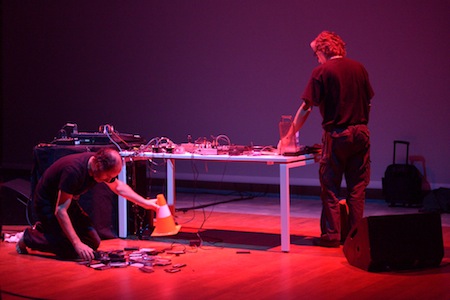
Quels rapports faites-vous entre vos activités de créateur sonore et de mathématicien ?
[ What is the relation between your activity as a sound artist and that of a mathematician? ]
And yep! That is the third book ... It will start by explaining how, when Iannis Xenakis died, and I went to Père Lachaise to attend his incineration, together with somebody else that I bumped into when exiting from the metro (we actually followed one another), I ended up at the wrong funeral...
A suivre! ;-)
...
notes __ ::
(*) Art Zoyd's Gérard Hourbette in a message on the aftermath of the November 13 kilings in Paris.
[
^ ]
(**) "I saw you / I see you / I see you / I saw you / . . . / I see you / I see you / I see you / I see you" __ (post scriptum: Un hélicoptère du secours en montagne était sur place rapidement. Si oui ou non les sauveteurs arrivaient à l'heure, ça reste une question ouverte.)
[
^ ]
more (transcribed) interviews with the author of the SoundBlog 🤓
(february 18, 2025) - Going Dutch in the KunschTTurm Club, Mulhouse
(december 12, 2020) - Songs of Praise (24 lullabies for a sick world)
(september 26, 2015) - "Never look back, unless to look forward."
(july, 2003) - hars :: the mp3mabf - chaz - interview
Read all about Found Tapes, Foundtaping and Audio Cassettes (K7s) on the SoundBlog:
(2023, september 21) - Holland[s] Spoor
(2022, january 11) - 'The Art of K7', vol. 1
(2021, september 11) - The Art of K7 :: Sudokaising [ii] Time Folds
(2020, march 21) - The Art of K7 :: Sudokaising [i]
(2019, november 17) - Foundtapers & Foundtaping in Porto
(2019, februay 08) - CCNL :: Cassette Culture in Linz, Austria
[ii] The aesthetics of erasure
(2019, januay 18) - CCNL :: Cassette Culture in Linz, Austria
[i] Oral history
(2015, november 22) - Situasonnisme: the City Sonic Festival
(2014, june 19) - Lecture de Cassette
(2013, october 25) - The Art of K7 (prelude) [sketch/book, 1]
(2013, march 23) - "Ma première cassette était vierge..." Mourning & celebrating 50 years of compact cassette
(2012, july 26) - UnOfficial Release
(2010, november 28) - Foundtaping, Maps & Shadows
at the Basel Shift Festival (i.)
(2009, november 15) - prof. dr. Cassette
(2009, november 08) - A found tapes meta-map
(2009, october 22) - Founded Tapapes
(2009, september 20) - Found Lost Sound
(2009, july 26) - "You, a bed, the sea ..." [ 1. Athens, sept. 28th 1994 ]
(2009, may 23) - It feels like summer in the city [KT2009, i]
(2009, february 19) - Time and the weather - "? Footage or Fetish" @ Käämer 12, Brussels (ii)
(2009, january 30) - A Tingel Tangle Tape Machine - "? Footage or Fetish" @ Käämer 12, Brussels (i)
(2009, january 15) - Kassettenkopf
(2008, december 08) - un-Tuned City (foundtaping in Neukölln)
(2008, september 14) - Psycho/Geo/Conflux in Brooklyn, NY __i.
(2008, august 31) - " Le chasseur " (foundtaping in brussels_ii)
(2008, june 18) - "Sing Laping, Sing !" (foundtaping in brussels_ i)
(2008, january 06) - Mo' Better Mo-Tapemosphere, 2. Restmuell
(2007, june 16) - Mo' Better Mo-Tapemosphere, 1. "chase away all my fear"
(2007, march 07) - Back to Berlin 2. Found Tapes
(2006, september 28) - jenny likes poets
(2006, september 06) - the sound of almost-no-more words
(2006, june 13) - fotex #49-51
(2006, june 04) - Sonofakunsttoer
(2006, april 17-25) - 'sudoku-solution' in 'de nor'
(2006, january 19) - ride, buggy, ride ... !
(2006, january 13) - axiologie for dummies
(2005, november 06) - found in maastricht
(2005, august 28) - tête-de-tettine / tête-de-cassette
(2005, august 23) - tape busters and coordinates
(2005, july 02) - Conquering America ...
(2005, june 03) - stationed soother
(2005, april 21) - Low-fi : the new Readymades
(2005, march 24) - d_Revolution #1 ...
(2005, february 07) - found tapes for spies
(2005, january 28) - "parfois l'amour tourne à l'obsession ..."
(2004, november 06) - à la tranquilité
(2004, july 20) - instructions in arabic
(2004, may 08) - phound stufphs
(2003, august 04) - new acquisitions #7, #8
(2003, may 04) - r2r
(2003, april 24) - splice and tape
(2003, april 15) - new acquisitions #5,#6
(2003, january 09) - finders keepers
(2002, november 24) - exhibit #4
(2002, november 08) - what fascinates me
(2002, november 07) - more on found tape montage
(2002, september 14) - detour
(2002, september 09) - 2 down, 3 to go
(2002, september 06) - magnetic migration
Read about Found Tapes in Gonzo (Circus) [Dutch]:
Gonzo #163, mei/juni 2021 - Lang Leve Lou Ottens
Gonzo #137, januari/februari 2017 - Het Kaf en het Koren
tags: City Sonic, free improvisation, glitch
# .464.